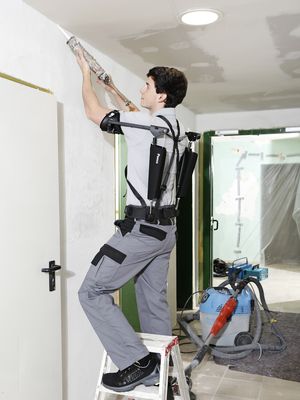KANBrief 3/19

Around 23% of employees in Germany are required to lift and carry heavy loads, 14% to adopt unfavourable body postures whilst working (cf. BMAS, BAuA. Sicherheit und Gesundheit bei der Arbeit 2016 (pdf, in german)). Exoskeletons, assistive systems worn on the body, are intended to make these tasks easier. Originally developed for military applications or medical rehabilitation, they are now also finding their way into the world of work. How do exoskeletons work? What opportunities and risks do they present?
The use of exoskeletons is in principle advantageous in any work environment where heavy loads must be moved manually or tasks performed in an unfavourable body posture and where other technical equipment such as fork-lift trucks, cranes or vacuum lifters cannot be used for this purpose. The use of assistive systems worn on the body is also conceivable as part of corporate return-to-work management or for the inclusion of employees with disabilities.
Active exoskeletons possess an electric or pneumatic drive, requiring a power supply. They may be modular and extensible in form, enabling multiple parts of the body to be supported. Since active exoskeletons are very complex and often have a high dead weight, they have met with low acceptance in industry so far.
Passive exoskeletons function purely mechanically, for example by means of spring systems that absorb energy during certain body movements and release it again to provide the required support. They do not require a power supply, and generally support only individual body regions. Since they are lighter and cheaper than their active counterparts, they have met with significantly
greater acceptance in companies.
The EU directive or regulation under which exoskeletons fall is currently a subject of discussion at European level. They could conceivably be regarded as technical means under the Machinery Directive 2006/42/EC. Annex 1 of this directive describes objectives of protection that could already provide orientation for the avoidance of hazards when exoskeletons are used. Where exoskeletons are used for the purposes of occupational rehabilitation or the inclusion of persons with disabilities, European Directive 93/42/EEC for medical devices (transposed as the Medical Products Act [MPG] in Germany) could be applied. Since exoskeletons are intended to protect against overloading of the body during lifting or carrying tasks or during work performed in constrained postures, considering them under Regulation (EU) 2016/425 governing personal protective equipment is also being discussed.
Possible hazards posed by exoskeletons must be identified and evaluated during the risk assessment. Owing to a dearth of relevant studies, this is however not yet possible. For example, does the wearing of an exoskeleton every day lead in the longer term to muscle atrophy, and if so, how should this be assessed? When work is performed overhead with an exoskeleton for longer periods, how soon may circulatory disorders in the arms be anticipated? On active exoskeletons, malfunction of the drive or control systems may lead to injuries. The same applies to malfunctions caused by operator error.
In order for the risks presented by the use of exoskeletons to be identified and evaluated, the German Social Accident Insurance Institution for the trade and distribution industry (BGHW) launched the Exo@work project in 2018, in which exoskeletal systems in working environments are being evaluated. The aim of the project is the development of a guidance document (in german) containing recommendations with the aid of which hazards, adverse impacts upon health, acceptance and ease of use can be determined and evaluated systematically.
It must be noted that exoskeletons are at the bottom of the hierarchy of protective measures (technical – organizational – personal). All possible technical and organizational measures must therefore first be exploited to the full in order for the handling of heavy loads or the performance of work in constrained postures to be avoided. Only when this is not possible is a personal measure – in this case the use of an exoskeleton – justified. These products should always be accompanied by appropriate behavioural measures such as instruction and exercises.
Ralf Schick
r.schick@bghw.de
The market for exoskeletons may still be in its infancy, and research, development and field tests currently the order of the day. Nevertheless, the question of standards is being raised more and more frequently. Together with the BGHW, the party performing the exo@work study and DIN, KAN has organized a workshop to discuss a possible standardization project concerning exoskeletons. Besides definitions, the standard could set out primary, general technical and ergonomic requirements and recommendations concerning the introduction of exoskeletons.